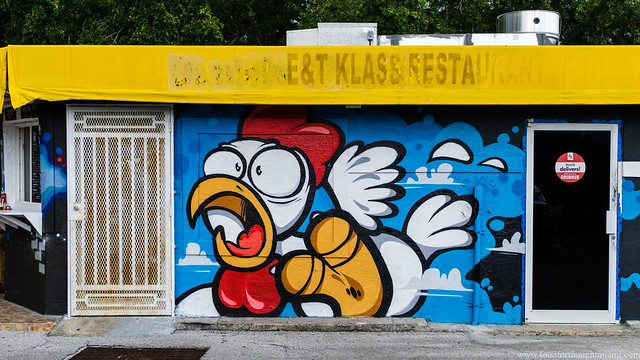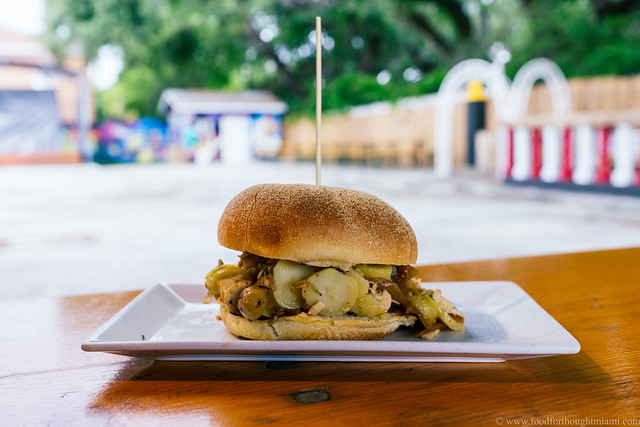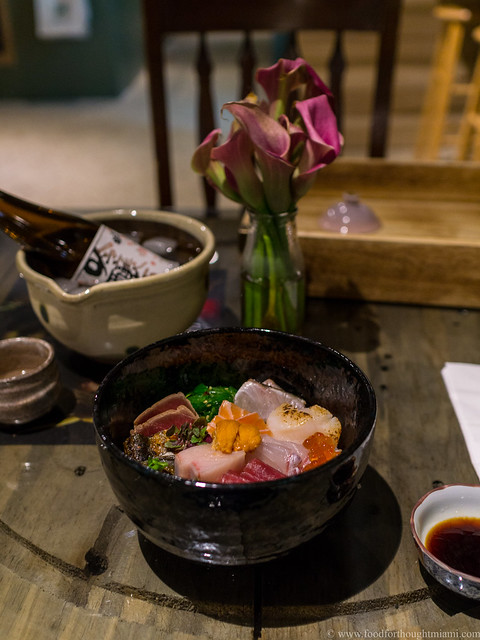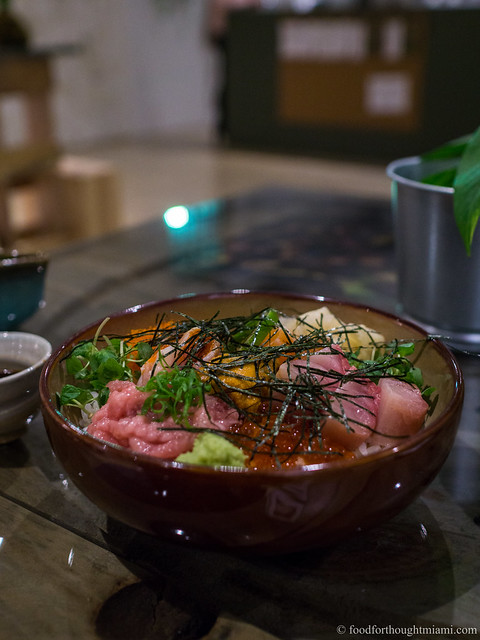▼
Wednesday, June 20, 2018
first thoughts: Sixty10 Organic Rotisserie Chicken | Little Haiti (Miami)
In the kitchen, unitaskers are anathema. All those avocado slicers and egg peelers and meat shredders just do the same things you can do with standard kitchen tools while taking up extra space in your drawers. As Alton Brown used to say on Good Eats, "The only unitasker allowed in my kitchen is a fire extinguisher."
When it comes to restaurants, though, I'm a big fan of unitaskers. Focus on just one thing, and you're more likely to do it well. Case in point: Sixty10 Organic Rotisserie Chicken, recently opened in Little Haiti. There are several items on the menu at Sixty10, but they are all essentially variations on one theme: chicken, rubbed with salt and spices, and cooked on a rotisserie until its skin is well-bronzed and its flesh pulls apart in soft, juicy ribbons. It may come as a whole, half or quarter chicken, along with a few different sandwich or salad iterations, but it's all about the bird. And happily, it's a really tasty bird.
(You can see all my pictures in this Sixty10 flickr set).
On a first-time lunch visit last week, I got the Sixty10 sandwich: pulled rotisserie chicken meat, a tangle of caramelized onions, coins of fingerling potatoes slippery with chicken jus, all smooshed inside a kaiser roll It was simple, straightforward, and delicious. The seasonings are subtle, not overpowering; it tastes like chicken, but actually like chicken, not just a bland blank canvas. Having said that, a smear of mustard or a daub of hot sauce would probably do it wonders.
I'll have to make a return visit to bring a whole roasted chicken home for the family, which can be had with two sides (options include those roasted potatoes, a creamy, tangy cole slaw, brussel sprouts or green beans) and two sauces (could be jalapeño jam, curry sauce, or pikliz, a nod to the Little Haiti neighborhood, among others) for $34. That's about 50% more than you'd pay for a commodity chicken family meal at Pollo Tropical and it's probably about 200% better.
There's not much to the place right now, which used to be a Haitian Creole take-out joint: a window into the kitchen where you place your order, a covered patio with some tables and benches if you want to "dine in." But there's a huge, sprawling yard out back, partly shaded by live oaks spreading their branches over from the neighboring property, and the owners have bigger long-term plans: live music (a stage is already set up), a chickee hut (plans have been filed with the city), wine and beer in a picnic-style atmosphere (there's no liquor license yet, so for now they're sometimes pouring wine for free).
(continued ...)
Friday, June 15, 2018
Wabi Sabi by Shuji | Upper East Side (Miami)
My first taste of chef Shuji Hiyakawa's food came at an event last spring hosted by the Japanese Consulate in Miami, described as "Culinary Secrets of Traditional Washoku." "Washoku" literally means "Japanese food," but more specifically, the traditional cuisine of Japan (here's a good primer). After breaking down a whole tuna loin and making sushi of it, Chef Shuji also served a variety of other less heralded Japanese items: a seasonal dish of hotaru ika (firefly squid) with fresh bamboo shoots, yu choy in dashi broth with bonito flakes, sweet soy-braised root vegetables.
At the time, Chef Shuji, who made his way from Fukuoka, Japan to Miami by way of Philadelphia, where he had worked for several years as executive sushi chef for Morimoto, was weeks away from opening his own restaurant, Dashi. I went to Dashi shortly after it opened (you can read my first thoughts) and came away pretty impressed, albeit dismayed by the absence of a conventional sushi bar. But Dashi closed only a few months later after Hurricane Irma caused extensive damage to the River Yacht Club, where the restaurant was situated.
Fortunately, Chef Shuji had a back-up plan. Turns out he was already at work on another concept in a different space – and even better (for me, anyway), it was right along the path of my daily commute, in Miami's "Upper East Side" on N.E. 79th Street just over the Causeway from Miami Beach. In early January, Wabi Sabi by Shuji opened.
(You can see all my pictures in this Wabi Sabi by Shuji flickr set).
It's a simple but striking space, built out and decorated almost entirely by Chef Shuji himself. Across one wall sprawls a flock of multi-colored origami cranes. A table underneath is laid out with enough beautiful Japanese ceramics to serve a feast for about ten people (more on that later). Hanging from the ceiling and resting on counters are an abundance of kokedama moss ball planters. A few rough wood tables provide seating for maybe a dozen diners. At the back, there's a small kitchen island where you'll find Chef Shuji and assistant chef Maggie Hyams working away, and on some days, marketing and event coordinator Koko Makoto working the register, serving as hostess, and doing everything else that needs doing with grace and charm.
There's still no sushi bar. Rather, the idea of Wabi Sabi combines some Japanese tradition with the latest in American fast-casual trends: food in bowls. We all love food in bowls these days. Buddha bowls, poke bowls, power bowls, acai bowls – seems we'll eat anything if you put it in a bowl.[1] While some food trends are just plain stupid, this is one I can get behind: it's convenient, it's right-sized portioning, and when you put nice things in the bowl, it can be both delicious and aesthetically pleasing.
Which are also some of the things I love about Wabi Sabi. The menu at Wabi Sabi is straightforward: a choice of four different combinations of raw fish and accompaniments, over a choice of four different bases (sushi rice, a multigrain mixture, green tea soba noodles, or salad greens), with a choice of four different sauces – served in a bowl.[2] Any of the basic configurations will run you between $11 (for a vegetarian version which includes cucumber, avocado, scallion, seaweed salad, soy-marinated shiitake mushrooms, carrots and radishes) and $18 (for a fully decked out version with tuna, salmon, lump crab, tobiko, and an assortment of vegetables).
Or, for the ballers out there, there's also an "omakase" bowl, which features an ever-changing assortment of fish and seafood, much of it flown in straight from Tsukiji Market in Japan, served chirashi style over seasoned rice. That may mean blocks of fatty hamachi (yellotwail), ribbons of silky, clean kinmedai (golden-eye snapper), shimmering sayori (half-beak), creamy uni (sea urchin), silver-skinned aji (horse mackerel), house-cured iwashi (sardine) or kohada (gizzard shad), baubles of ikura (salmon roe), or any number of other possibilities, served over a bowl of seasoned rice, with seaweed salad, maybe some sprouts, maybe some soy-cured shiitake mushrooms, and a scatter of shredded nori batons.
Unlike the standard menu options, the omakase bowl is not cheap – pricing usually runs between $35 and $40, depending on what ingredients are featured that particular day. But if you add up what you would pay for a comparable sashimi or sushi order at any good sushi-ya – and the quality of the ingredients at Wabi Sabi is on par with what you'll find at the few places in Miami that fit that description – I think you'll find it to be roughly equivalent. It is also probably the easiest, most convenient way to eat some great sushi that you'll find in Miami, one that you can even take home and eat in front of the TV if you wish.
(continued ...)
At the time, Chef Shuji, who made his way from Fukuoka, Japan to Miami by way of Philadelphia, where he had worked for several years as executive sushi chef for Morimoto, was weeks away from opening his own restaurant, Dashi. I went to Dashi shortly after it opened (you can read my first thoughts) and came away pretty impressed, albeit dismayed by the absence of a conventional sushi bar. But Dashi closed only a few months later after Hurricane Irma caused extensive damage to the River Yacht Club, where the restaurant was situated.
Fortunately, Chef Shuji had a back-up plan. Turns out he was already at work on another concept in a different space – and even better (for me, anyway), it was right along the path of my daily commute, in Miami's "Upper East Side" on N.E. 79th Street just over the Causeway from Miami Beach. In early January, Wabi Sabi by Shuji opened.
(You can see all my pictures in this Wabi Sabi by Shuji flickr set).
It's a simple but striking space, built out and decorated almost entirely by Chef Shuji himself. Across one wall sprawls a flock of multi-colored origami cranes. A table underneath is laid out with enough beautiful Japanese ceramics to serve a feast for about ten people (more on that later). Hanging from the ceiling and resting on counters are an abundance of kokedama moss ball planters. A few rough wood tables provide seating for maybe a dozen diners. At the back, there's a small kitchen island where you'll find Chef Shuji and assistant chef Maggie Hyams working away, and on some days, marketing and event coordinator Koko Makoto working the register, serving as hostess, and doing everything else that needs doing with grace and charm.
There's still no sushi bar. Rather, the idea of Wabi Sabi combines some Japanese tradition with the latest in American fast-casual trends: food in bowls. We all love food in bowls these days. Buddha bowls, poke bowls, power bowls, acai bowls – seems we'll eat anything if you put it in a bowl.[1] While some food trends are just plain stupid, this is one I can get behind: it's convenient, it's right-sized portioning, and when you put nice things in the bowl, it can be both delicious and aesthetically pleasing.
Which are also some of the things I love about Wabi Sabi. The menu at Wabi Sabi is straightforward: a choice of four different combinations of raw fish and accompaniments, over a choice of four different bases (sushi rice, a multigrain mixture, green tea soba noodles, or salad greens), with a choice of four different sauces – served in a bowl.[2] Any of the basic configurations will run you between $11 (for a vegetarian version which includes cucumber, avocado, scallion, seaweed salad, soy-marinated shiitake mushrooms, carrots and radishes) and $18 (for a fully decked out version with tuna, salmon, lump crab, tobiko, and an assortment of vegetables).
Or, for the ballers out there, there's also an "omakase" bowl, which features an ever-changing assortment of fish and seafood, much of it flown in straight from Tsukiji Market in Japan, served chirashi style over seasoned rice. That may mean blocks of fatty hamachi (yellotwail), ribbons of silky, clean kinmedai (golden-eye snapper), shimmering sayori (half-beak), creamy uni (sea urchin), silver-skinned aji (horse mackerel), house-cured iwashi (sardine) or kohada (gizzard shad), baubles of ikura (salmon roe), or any number of other possibilities, served over a bowl of seasoned rice, with seaweed salad, maybe some sprouts, maybe some soy-cured shiitake mushrooms, and a scatter of shredded nori batons.
Unlike the standard menu options, the omakase bowl is not cheap – pricing usually runs between $35 and $40, depending on what ingredients are featured that particular day. But if you add up what you would pay for a comparable sashimi or sushi order at any good sushi-ya – and the quality of the ingredients at Wabi Sabi is on par with what you'll find at the few places in Miami that fit that description – I think you'll find it to be roughly equivalent. It is also probably the easiest, most convenient way to eat some great sushi that you'll find in Miami, one that you can even take home and eat in front of the TV if you wish.
(continued ...)






